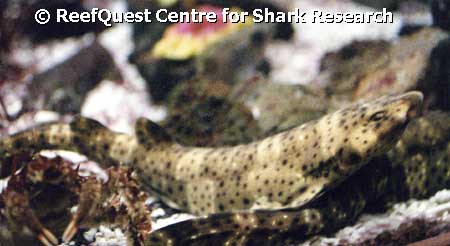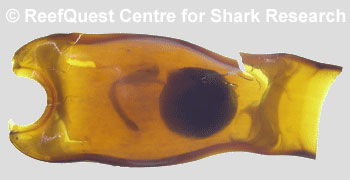Kelp Forests: Cathedrals in the Sea
Swell Shark
Named for its ability to inflate itself with seawater, the Swell Shark (Cephaloscyllium ventriosum) is a fascinating kelp forest inhabitant even before it hatches from its egg case. Due to its abundance, relatively small size, and sedentary habits, this species adapts readily to aquaria and is a convenient subject for laboratory research. But, as is so often the case with sharks, little is known about its life in the wild.
Just the Facts:
Size:
Reproduction:
Diet:
Habitat: Rocky Reefs, Kelp Forests, Deep Sea Depth: 16-1500 ft (5-457 m), commonest from 16-120 ft (5-37 m) Distribution: Tropical Eastern Pacific, Chilean |
Exactly how the little Swell Shark can inflate itself with water was first studied shortly after World War II. It was discovered that — unlike pufferfishes (teleosts of the superfamily Tetraodontoidea), which inflate by pumping water into a special, highly distensible sac along the belly — the Swell Shark simply swallows water and holds it in the cardiac (forward) potion of its stomach. Swallowed water is prevented from exiting the stomach by the cardiac sphincter, a ring-like muscle at the opening of the stomach. Through this simple mechanism, the Swell Shark can rapidly increase its diameter two or three times.
Inflation is believed to be part of the Swell Shark’s anti-predator strategy. Underwater observation of Swell Sharks in the wild has revealed that inflation is merely the beginning of their defensive tactic. When threatened, a Swell Shark typically bolts for the nearest convenient rocky crevice (which are abundant in the kelp forest environment) and enters it head-first. Once inside, the Swell Shark curls into a U-shape and — with its head and tail innermost — inflates its stomach. As a final touch, the Swell Shark grasps its caudal fin between its teeth, thereby presenting to the hostile outside world a fat, inflated ‘inner tube’ that is wedged into its rocky shelter in a way that is extremely difficult for biting predators to evict.
Like the Horn Shark (Heterodontus francisci), the Swell Shark is nocturnal. Intriguingly, although both these sharks inhabit the same habitat and geographic range, they rely on different cues to rouse them from their daytime inactivity. Laboratory experiments have demonstrated that Horn Sharks respond directly to ambient light levels, becoming active whenever it is dark — no matter what the time of day. In contrast, Swell Sharks maintain a fairly strict regimen of 12 hours’ diurnal torpor followed by 12 hours’ nocturnal activity — no matter what the ambient light levels. Interestingly, just like humans under constant darkness, the experimental Swell Shark’s activity rhythm shifts a little earlier each day, while under conditions of constant light, its rhythm shifts a little later each day. From these results, the researchers concluded that the Horn Shark’s activity patterns are controlled externally, while those of the Swell Shark are controlled through an internal mechanism. This mechanism is probably the same one (cyclical shifting of relative concentrations of the hormones melatonin and serotonin in the brain’s pineal organ in response to seasonal changes in day-length) that governs human circadian rhythms.
Experiments off Santa Catalina Island, California, indicate that the nocturnal Swell Shark relies on electroreception to detect its prey. Numerous sharks were presented with an apparatus terminating in a fish-holding chamber with an agar cap that eliminated all visual and olfactory cues, but remained permeable to electric fields. Swell Sharks ignored the empty chamber but gaped or bit when it contained a live fish behind an agar cap. When the agar cap was replaced with a plastic one impervious to electric fields, the sharks ignored the chamber. At distances of 8 inches (20 centimetres) or less, Swell Sharks could clearly detect the tiny electrical signature generated by the life processes of a fish. In this way, Swell Sharks can detect uninjured prey that they can neither see nor smell.
Predatorily speaking, the Swell Shark is a study in contrasts. This species has a relatively large mouth — proportionally wider than that of the White Shark (Carcharodon carcharias) — yet is armed with tiny, multicusped teeth. Such oral equipment is well suited to grasping prey almost as large as the head, but not to sawing it into smaller pieces. Swell Sharks are relatively inefficient swimmers, employing a tadpole-like wriggle that would not enable them to overtake any but the slowest of prey. But dietary studies suggest that their prey includes relatively fast-swimming species, such as the gregarious damselfish known as Blacksmith (Chromis punctipinnis). At night, Blacksmith take shelter in or near rocky crevices, relying for protection on their quickness and agility. How do Swell Sharks manage to capture such speedy prey?

Predatory behavior of Swell Sharks has been investigated at Santa Catalina Island, California. These nocturnal sharks employ at least two strategies for feeding on Blacksmith. One method of prey-capture used by Swell Sharks is called “rapid-gulp” behavior. In this method, the shark lies patiently until its victim is a few inches (centimetres) from its head. By a sudden, rapid expansion of the Swell Shark’s mouth and throat, it sucks the fish into its toothy maw. The alternative prey-capture method is termed “yawn” behavior. This consists of a gradual opening of the mouth as a Blacksmith drifts close to the head of a prone Swell Shark. When it carelessly swims into the gaping mouth of the waiting shark, the unwary fish is captured by a sudden snap of the predator’s large jaws. Thus, Swell Sharks rely on ambush to capture Blacksmith and probably other fast-swimming prey.
Swell Sharks are highly sociable, often lying together in loose aggregations during daylight hours. Sometimes, these gregarious sharks even pile up on one another, stacked like cord wood. Yet nearby populations do not seem to mix. One study found distinct differences among Swell Sharks from Santa Catalina Island and the California mainland. Most strikingly, egg cases from Santa Catalina had very short tendrils (less than 1 inch or 2 centimetres in length) compared with those from the mainland (where tendril length ranged from 31 to over 79 inches [80 to 200 centimetres]). These tendrils serve to anchor the egg cases during development. The California mainland frequently experiences moderate to heavy surf, while the inshore waters of Santa Catalina rarely undergo surf action. Thus, the observed differences in Swell Shark egg case tendril length between these locations may be an adaptation to the degree of anchoring required. These regional differences in tendril length are consistent in egg cases no matter whether they are laid in the wild or in laboratory aquaria. This suggests genetic rather than environmental control, indicating that Swell Sharks from Santa Catalina Island do not interbreed with those from the California mainland.
|
|
Like those of the Horn Shark, Swell Shark egg cases are subject to predation. Of 42 Swell Shark egg cases collected at Santa Catalina, 29 (69%) had one or more holes in them. These holes were circular with ragged edges and tapered toward the center, apparently bored by the radula (toothy tongue) of one or more species of predatory snail. Of the 29 empty cases with closed ends, indicating that the pup within did not successfully hatch, 26 (90%) had these bore holes. This suggests that predation by carnivorous snails may be an important source of mortality in Swell Shark eggs.
Starting life packaged in an egg case creates further challenges for a developing Swell Shark. While the embryo develops, it is trapped inside a sealed container that allows very limited exchange of oxygen with the surrounding seawater. A recent study found that Swell Shark hemoglobin (the oxygen-carrying molecule in the blood of sharks, humans, and many other creatures) changes structure as the animal grows. More intriguingly, the hemoglobin of pre-hatch Swell Sharks has a much higher affinity for oxygen than that of adult individuals. In fact, the hemoglobin of pre-hatch sharks became 50% saturated with oxygen at less than half the ambient pressure required to reach the same saturation in that of adults. This higher affinity for oxygen in fetal Swell Sharks many enable them to more efficiently extract oxygen from the relatively stagnant environment within the egg case.
Even in the simple act of hatching, the Swell Shark employs a remarkable trick. Its back is equipped with a double row of enlarged dermal denticles with rearward-pointing cusps. These scutes act as an anti-slip ratchet to aid the young shark in forcing its way out of the egg case. Once hatched, a new-born Swell Shark is on its own — protected only by its self-defensive instincts and ability to learn.
At every stage of its life, from before it hatches to adulthood, the Swell Shark is a remarkably adaptable creature. It is able to deal with the challenges and take advantage of the opportunities imposed by its kelp forest habitat. In this respect, the humble Swell Shark is no less impressive than is its much larger and more famous cousin, the White Shark.
Swell Shark Bibliography
More about: Swell Sharks |
Sharks making Sounds


